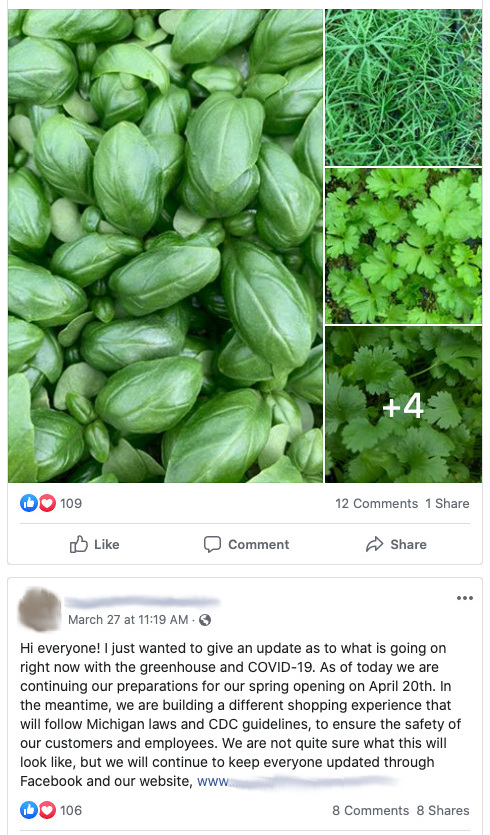Garden center retail survival strategy series: Communicating in extraordinary times
Own the moment with frequent, honest and persistently positive messages.

Part 2: Communicating in extraordinary times
A communication strategy is an essential part of any contingency plan.
Our businesses live and die by the strength of the relationships we have with our employees and customers. They are vital to the continued success of any operation and no act will serve us better than making sure our connection with these people remains healthy and strong. Communication is how we built these relationships; it's how we maintain them and it is the key to getting through these stressful times.
Communicating with employees
Your staff is your greatest asset. They are the heart and soul of the business and they need to know you are going to take care of them. In her Michigan State University Extension webinar “Garden Retail Strategies to Sell in the Current Environment,” Bridget Behe suggests a straightforward approach. “I want you to be thinking about frequent communications. Being honest. Being frank,” says Behe. Keep employees apprised of your plans to maintain a healthy work environment (Photo 2). Demonstrate, in words and actions, the steps you are taking to keep them safe and healthy. This is the hallmark of a good leader.
A daily screening process pulls double duty, allowing you to connect with your staff and protect them at the same time.
- Ask them how they feel
- Ask them if they have any symptoms.
- Review and reinforce hygiene protocols.
“I know we’ll all be tired of those hygiene messages, but we really need to reinforce them,” says Behe, nothing that the Centers for Disease Control (CDC) has an excellent set of resources with guidelines for keeping businesses and employees as safe as possible.
Some Michigan municipalities already require essential service providers and businesses to screen their staff. We should all expect our local governments to adopt similar requirements. Want to get ahead of the curve? Ingham County provides a workplace checklist and a set of screening questions on their website.

Communicating with customers
Our industry is a very hands-on industry. Customers come to independent garden centers and florists for the personalized experience they simply can’t get at larger chain stores. The challenge we face now is to provide that same level of personal service at a distance. It is the very opposite of what we are accustomed to doing. So how do we build and maintain those personal connections when our retail stores are closed to the public?
Social media is one of the quickest ways to broadcast a message and is arguably the most cost-effective (free) means of remote consumer engagement. Company websites work well for this too.
But it’s not just what we say, it’s how we say it. Tone is everything.
A model for communicating in a crisis
"I really like this HEART framework of crisis communication that came out in the Harvard Business Review,” says Behe. In their article, Ted Waldron and James Wetherbe from Texas Tech University propose five strategies that can help businesses survive troubling times and maintain those all-important connections with consumers.
Humanize your company
Educate about change
Assure stability
Revolutionize offerings
Tackle the future
Here’s how it might look when applied to garden centers right now.
Humanize your company
- Express empathy for those affected by the crisis — be genuine and sincere.
- Explain how you’re helping employees, customers and community.
The message: People over profits. The health and safety of the community is of the utmost importance. Here's what you are doing to provide a safe workplace for your employees and a safe shopping experience for your customers.
Notes: Social media is the perfect place to post photos of the steps you are taking to protect customers and the community, but keep these messages short and sweet.
Educate about change
The message: Things are going to be different this year. Here are all the changes we are making to normal operating procedures to ensure the health and safety of everyone involved (see a great example in Photo 3).
Notes: Be proactive. Don't wait for the government mandate. Get ahead of the curve.

Assure stability
If you haven't already, make a list:
- What are the things your business does well?
- Why do customers come to your business instead of others?
The message: Even in these challenging times, consumers can count on you for the same products and services that they have come to expect.
Notes: Let your light shine! These messages should ooze positivity. Highlight one item from your list per day and include an appropriate photo. If you can get photos with staff in action, even better. People really need the human connection right now.
Revolutionize offerings
Innovation to address a critical need shows you care about the well-being of your customers.
The message: The crisis has presented some problems; here are all the new products and services you are offering to solve those problems. When life hands you lemons...
Notes: See the article “Thinking through the shopping experience” for some interesting suggestions.
Tackle the future
The message: The government has established guidelines or restrictions. Here's what you are doing to go above and beyond those restrictions and keep people extra safe. Here's what you learned in the process and here are some of the things that you might continue doing even after the crisis is over. Your business is flexible, resilient and will emerge from this crisis in a stronger position than when it started.
Notes: One way to show you are going above and beyond is to make it obvious that you can maintain these new measures indefinitely. Consider retaining any changes to your product or service offerings that have become popular with your customers.
Beyond the framework
In the current environment, positive messaging may be the most important component of your communications strategy. “We really don't need to see any more images of that coronavirus, we need to see pretty plants, we need to see fruits and vegetables”, remarks Behe. For those that need to jumpstart their marketing campaign, she recommends using some of the inspiring messages from the National Garden Bureau (Photo 4) and materials from the “Plants Do That” section on the National Initiative for Consumer Horticulture website (Photo 5). “We want to encourage them to buy local, to #GardenStrong and show that #PlantsDoThat,” and adds, “These are powerful messages that we need to be sharing, each of us, all the time.”





 Print
Print Email
Email




